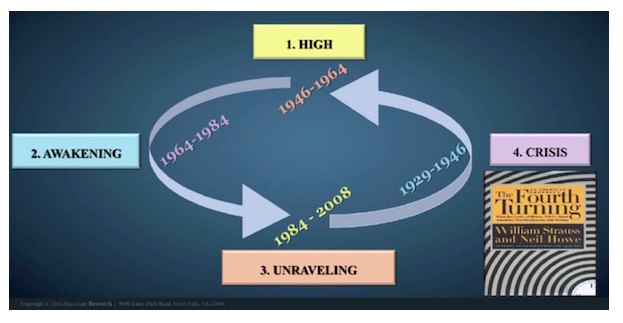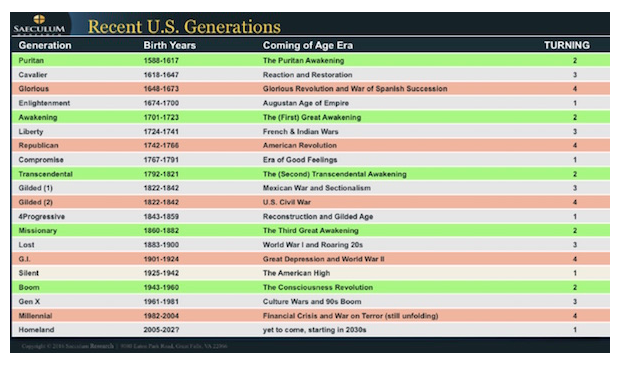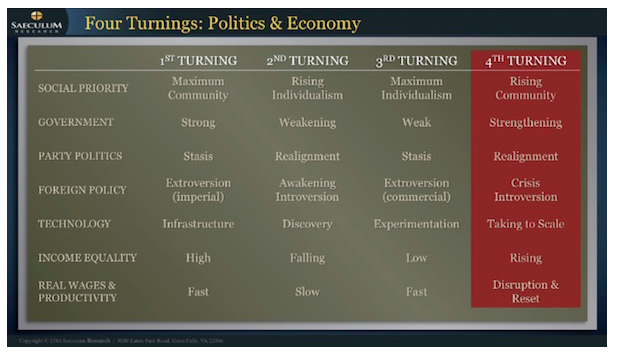After the Nomad archetype, the cycle repeats with another Hero generation, the Millennials (born from 1982 through about 2004), who are beginning to take root in American culture. They are a large generation numerically, filling schools and colleges and propelling new technology into the mainstream. If the pattern holds, they will face a great crisis. It will influence the rest of their lives just as World War II shaped the G.I. Generation Heroes.
And guess what: we are all in that crisis right now.
A Turning Roughly Every 20 Years
If Strauss and Howe are correct, the four generational archetypes literally created Anglo-American history. A new era, or “turning,” begins every twenty or so years. Four turnings bring a complete cycle, matching the 80–90 year human lifespan.
The Romans used the word Saeculum to describe this length of time, meaning “a long human life” or “a natural century.” In their book Generations, Strauss and Howe outline seven full saecula, going back to the 15th century. Much like the changing seasons, the turnings within each saeculum follow a recurring pattern.
The first turning is called a High, a confident time in which social institutions are strong and factions pull together for the greater good.
The second turning is the Awakening. This period is marked by cultural and religious renewal – changes accompanied by resistance and conflict.
The third turning is an Unraveling. People lose trust in institutions and embrace individualism.
The fourth turning is the Crisis, a time of major upheaval when some great threat forces a redefinition of core institutions and public behavior.

US history confirms that the pattern is more than coincidental. Begin with a day when crisis was triggered: December 7th, 1941. The attack on Pearl Harbor might not (or at least should not) have been as surprising as many think, but it did mark the onset of a new crisis for a nation already dealing with the Great Depression.
Eighty-five years earlier, Confederate forces fired on Fort Sumter, launching the Civil War and redefining the core institutions surrounding state’s rights and individual rights.
Dial the calendar back another eighty-five years, and we find a group of men in Philadelphia committing lives, fortunes, and sacred honor by signing the Declaration of Independence.
The pattern continues: four generations before the American Revolution our country experienced the 1689 “Glorious Revolution.” One lifespan earlier the English navy defeated the Spanish Armada, which followed by a century the bloody War of the Roses, creating Tudor England as a modern nation-state.
Halfway between these crisis periods we see Awakening periods like England’s Protestant Reformation, the American Transcendental era of the 1820s and ’30s, and the 1960s American spiritual and social upheaval. Like the seasons, turnings unfold gradually, almost unnoticeably at first. They can also vary, just as we experience warm autumn days and springtime cold fronts.

Social forces drive the turnings, just as planetary forces create seasons. At any given time, four generation are alive: children, young adults, middle-aged, and elderly. Each experiences history from its own perspective. If you were six years old, listening to the radio with your 65-year-old grandmother on December 7, 1941, you heard about Pearl Harbor together. Your reactions, however, were quite different. You were on the way up; Grandma was on the way out. And if you were a young man or woman, your reactions were altogether different from those of the six- or the 65-year-old.
Guide to the Fourth Turning
Each Fourth Turning is a Crisis. When Howe uses that word, he doesn’t mean a short period of difficulty. He means an existential crisis, one in which society’s strongest instititions collapse (or are severely challenged and stressed) and national survival is in serious doubt. The Crisis can be economic, cultural, religious, military, or all the above.
Sound familiar? It should. By Neil Howe’s timeline, we are today about halfway through the Fourth Turning’s Crisis phase. We may have another decade to go. When it’s over, we will be able to look back and see that important changes occurred.

If this Fourth Turning is like previous ones, here is what we should see. See how the following Fourth Turning characteristics match today’s headlines. Remember, Howe and Strauss were writing all this in 1997, well before today’s events.
Rising Community: Notice in the Orlando shooting coverage how often people use the word community to designate the different groups with which people identify. Following the tragic nightclub events, Orlando’s communities drew together to support their members and each other. We see the same behavior in other stressful events. “Je suis Charlie,” the motto that emerged from the January 2015 Paris shootings, comes to mind. Think of all the other disasters we have seen in recent times, and the public response to them. I am not suggesting that community comes to the fore only during a Fourth Turning – far from it. But it does gain strength during such periods.








